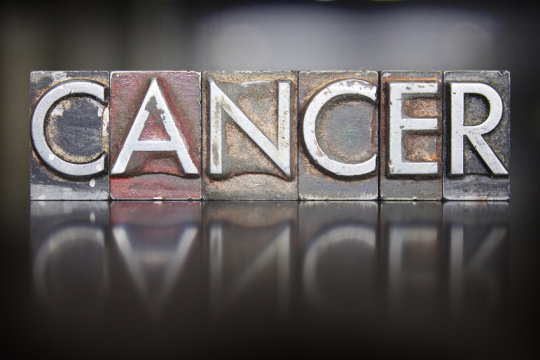A paper published today in the Proceedings of the National Academy of Sciences argues against the commonly held "accumulation of mutations" model of oncogenesis in favor of a model that depends on evolutionary pressures acting on populations of cells. Basically, the paper states that the ecosystem of a healthy tissue landscape lets healthy cells outcompete ones with cancerous mutations; it is when the tissue ecosystem changes due to aging, smoking, or other stressors, that cells with cancerous mutations can suddenly find themselves the most fit, allowing their population to expand over generations of natural selection.
This new thinking about oncogenesis has profound implications for cancer therapy and drug design.
"We've been trying to make drugs that target mutations in cancer cells. But if it's the ecosystem of the body, and not only cancer-causing mutations, that allows the growth of cancer, we should also be prioritizing interventions and lifestyle choices that promote the fitness of healthy cells in order to suppress the emergence of cancer," says James DeGregori, PhD, associate director for basic science at University of Colorado Cancer Center, and the paper's senior author.
The proposed model helps to answer a longstanding question in cancer science known as Peto's Paradox -- if cancer is due to random activating mutation, larger animals with more cells should be at greater risk of developing the disease earlier in their lives. Why then do mammals of vastly different sizes and lifespans all seem to develop cancer mostly late in life?
"Blue whales have more than a million times more cells and live about 50 times longer than a mouse, but the whale has no more risk than a mouse of developing cancer over its lifespan," DeGregori says.
The answer that DeGregori and CU Cancer Center colleague Andrii Rozhok, PhD propose is that in addition to activating mutation, cancer may require age-associated changes to the tissue landscape in order for evolution to favor the survival and growth of cancer cells over the competition of healthy cells.
Consider the following two evolutionary scenarios: In a grassy lawn, the health of the lawn is the best defense against dandelions; and in the time of the dinosaurs, the environment selected for giant lizards until the meteor hit at which point the new context favored the evolution of new species better adapted to the changed environment, including larger mammals.
Let's start with the lawn: "Healthy cells are optimized for the ecosystem of the healthy body. But when the tissue ecosystem changes, such as with aging or smoking, cancer-causing mutations are often very good at exploiting the conditions of a damaged tissue landscape," DeGregori says. In this scenario, DeGregori's suggestion to explore the development of interventions supporting the fitness of healthy tissues is like applying fertilizer to the lawn rather than herbicide to the weeds.
DeGregori's model is supported by studies showing that mutations that can cause cancer do not necessarily increase a cell's fitness. "In fact, healthy cells are so optimized to the healthy tissue landscape that almost any mutation makes them less fit," DeGregori says.
For example, some cancer cells mutate in a way that allows them to survive in the oxygen-poor tissue environments found in the center of developing tumors. But this adaptation only confers a fitness benefit in oxygen-poor tissues. In a healthy, oxygen-rich tissue, this mutation would not confer this advantage. In healthy tissue, cells with this mutation lose the evolutionary race to the healthy cells; cancer cells are outcompeted and they die, or at least their population is held in check and remains insignificantly small.
But what happens when the tissue landscape changes? This brings us to the dinosaurs. Sixty-five million years ago, a warm, wet planet favored dinosaurs, though a few early mammals scurried among them. Then the giant meteor hit (among other environmental changes happening around this time), altering the basic dynamics of the ecosystem. It was this adjustment to the ecosystem that allowed furry and feathered, warm-blooded creatures to eventually dominate earth.
It seems as if new, successful species are produced by new, successful genetic changes. But in this example, as in cancer, individuals with these "new" genetics may already exist and it is changes to the ecosystem that allow them to flourish. Yet cancer biologists focus on how cancer risk factors like aging and smoking create new mutations, instead of focusing on how these contexts alter tissue landscapes and thus alter selection for already-existing mutations. Supporting this idea, DeGregori points out that studies modeling stem-cell pools show that selection pressure from the tissue landscape is more powerful than mutations at deciding the makeup of a population of stem cells.
"When the body changes due to aging, smoking, inherited genetic differences or other factors, it changes the tissue ecosystem, allowing a new kind of cell to replace the healthy ones," DeGregori says.
Certainly, cancer development requires mutations and other genetic alterations. But how do these mutations cause cancer? It may not be that these mutations create accidental "super cells" that immediately run amok. Oncogenic mutations are often or always present in the body, but are kept at bay by selection pressures set against them. That is, until the tissue ecosystem and its pressures change in ways that make cells with cancerous mutations more likely to survive than healthy cells, over time allowing the population of cancer cells to overcome that of healthy cells.
We can avoid some of these tissue changes by lifestyle choices, such as by not smoking. Unfortunately, we can't put off aging forever. But there may be features of the tissue landscape that, with new therapies and new understanding, could be reinforced in ways resist cancer better, longer.
Source:
University of Colorado Anschutz Medical Campus. (2015, July 21). Evolution, not just mutation, drives development of cancer: Solving 'Peto's Paradox,' new model shows selection pressure of healthy tissue keeps cells with cancerous mutations in check. ScienceDaily. Retrieved August 19, 2015 from www.sciencedaily.com/releases/2015/07/150721134835.htm


